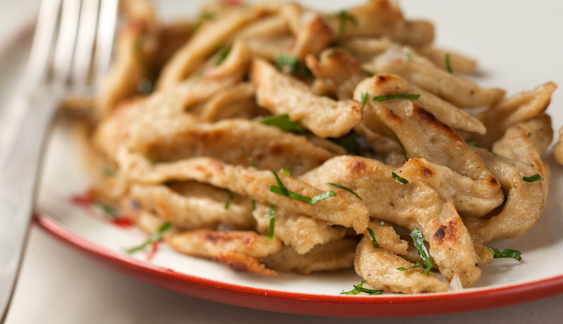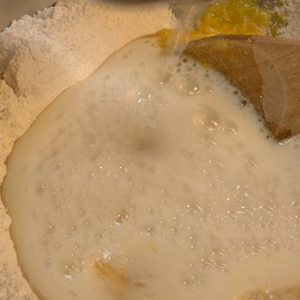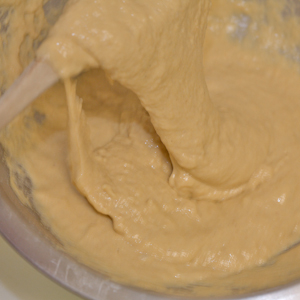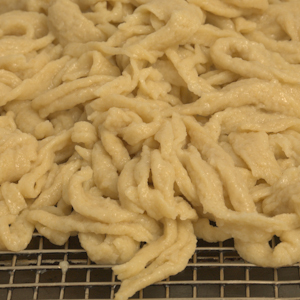Butter-Fried Spätzle

introduction
Spätzle are German noodles without borders. Dropped from a pastry bag, pressed through a potato ricer, or scraped past the holes of a grater into a bath of boiling water, spätzle is the ultimate protean mass: whatever shape the noodles find themselves in when they touch down is the shape they keep.
As with all noodles, there are good and not-so-good spätzle. Occasionally one finds spätzle of fine consistency (read not too rubbery); rarely, however, does one find spätzle with sweet, subtle flavor. Until now. Anson Mills Trigo Fuerte flour, a blend of soft, sweet wafer flour and spicy bread flour, has magical properties for creating spätzle with delicacy and flavor, that crisps in a skillet just like you want it to.
The fundamental appeal of spätzle is their light, chewy simplicity. They are a bit bouncier than rolled and cut noodles, and when they curl up in your mouth they’re a lot of fun. But plain boiled spätzle is nothing compared to butter-fried spätzle, which becomes super-anointed with appeal when it meets a hot skillet for a light browning. This is the moment when spätzle surpasses itself.
We like to chill the boiled spätzle to allow the starches in the flour to harden, then brown it in clarified butter, and finish it with whole, melted butter scented with sautéed shallots and fresh herbs.
Cooking Remarks
Beating spätzle is a manual operation: it involves a mixing bowl, a wooden spoon, and some elbow grease. German chefs say spätzle batter must be beaten until it throws big, lazy bubbles, a process which, given proper physical conditioning, takes about 10 minutes.
The liquid these chefs prefer for making spätzle? Sparkling water. The carbon dioxide in sparkling water offers a lightening effect to noodle doughs by creating air pockets that expand when the spätzle is cooked. Make sure your sparkling water is cold and under pressure when you use it.
Knowing just the right amount of sparkling water to add can be a tricky. Small discrepancies in flour measurements or the flour’s moistness versus dryness (due to how it was stored) can effect the batter’s hydration, so our recipe gives a range of liquid. Pay attention to consistency. Spätzle batter isn’t delicate: it’s got some heft and fight to it. The batter shouldn’t be so thick and sinewy that it arm wrestles you to the table as you beat it, but it shouldn’t be so weak and spindly that it shreds or snaps when lifted by the spoon in the bowl. The perfect consistency is like shiny liquid elastic. Add a bit more water or flour if the consistency is off and resume beating. To get the most from the carbon dioxide in the sparkling water, cook the späztle within 15 minutes of making the batter.
Spätzle needs clarified butter and high heat to take a proper browning. The spätzle also perform better in the pan when they are thoroughly chilled—which is why we suggest making them up to a day in advance.
Once boiled, the noodles are fairly delicate and like gentle treatment while being fried.
equipment mise en place
To make and boil the spätzle, you will need a wide, shallow stockpot or Dutch oven; a medium and a large mixing bowl; a wooden spoon; a large rimmed baking sheet; paper towels; a small cutting board or a glass pie plate with a flat bottom; a rubber spatula; a metal icing spatula; a perforated skimmer or mesh strainer; a footed colander; plenty of ice cubes; and a wire cooling rack.
To fry the spätzle, you will need a small saucepan; a small bowl; a large nonstick skillet; a pair of tongs; a warmed large mixing bowl; a wooden spoon; a heatproof rubber spatula; and a warmed serving bowl or platter.
-
-
8ounces (1½ cups plus 1 tablespoon) Anson Mills Trigo Fuerte Flatbread Flour
-
Fine sea salt
-
3large eggs
-
7 to 9tablespoons cold sparkling water
-
Vegetable oil spray
-
4ounces (8 tablespoons) unsalted European-style butter
-
Freshly ground black pepper
-
Freshly grated nutmeg
-
2shallots, minced (2 tablespoons)
-
2tablespoons mixed fresh chopped herbs, such as parsley, sage, or rosemary
-
-
Make the spätzle: Fill a wide, shallow stockpot or Dutch oven with water and bring it to a boil over medium-high heat.
-
In a medium mixing bowl, using a wooden spoon, mix the flour and 2 teaspoons salt. Make a well in the flour and crack the eggs into the well (fig. 2.1). Use the wooden spoon to beat the eggs, drawing a small amount of the flour into the well (fig. 2.2). When the eggs are well beaten and creamy, pour 7 tablespoons of the sparkling water into the well (fig. 2.3). Beat the water into the egg mixture, gradually drawing the flour into the well. When all the flour has been incorporated, beat the batter vigorously with the wooden spoon until it is shiny and elastic and throws large bubbles on the surface, about 10 minutes (fig. 2.4). If the batter is overly muscular and difficult to mix, add up to 2 tablespoons sparkling water so that it is beatable but still strong.
-
Check to make sure the water is at or near a boil. Increase the heat, if necessary, and add 1 tablespoon of salt. Fill a large mixing bowl with ice water and set it near the stove. Line a large rimmed baking sheet with a double thickness of paper towels.
-
Splash a small cutting board (one you can hold easily in one hand) or the back of a glass pie plate with water. Using a rubber spatula, scrape half of the späztle batter onto the board. Dip a metal icing spatula into the boiling water and smooth the batter—as if it were icing—flush with edge of the board into a band about 4 inches wide and ¼ inch thick. Holding the board aloft over the boiling water at a 40-degree angle, dip the spatula into the water, then use it to cut a thin ribbon of spätzle and sweep it into the water (fig. 4.1). Continue cutting and sweeping the spätzle into the boiling water, dipping the spatula in the water after each sweep to keep the batter from sticking. Work as quickly as you can so all the noodles cook at the same time. (However, precision isn’t paramount: these are noodles whose irregularity is, to some degree, part of their charm.) Cook the first batch in steadily boiling (but not raging) water until the noodles expand and are firm but light, about 3 minutes.
-
Use a perforated skimmer or mesh strainer to lift the spätzle out of the boiling water and lower it into the ice water (fig. 5.1). Stir gently until cool, and then, using the skimmer, transfer the spätzle to a footed colander set in the sink. Shake the colander to remove excess water and pick out any ice cubes. Turn the spätzle onto a lightly greased cooling rack (fig. 5.2), and then transfer it to the paper towel–lined baking sheet, spreading it in an even layer. Cook, cool, drain, and dry the remaining the spätzle in the same manner, and add it to the first batch. Cover with plastic wrap and refrigerate until chilled, at least 2 hours or up to 1 day.
-
Clarify the butter: Melt 6 tablespoons of the butter in a small saucepan over low heat. Remove the pan from the heat, tilt it gently, and, using a spoon, skim off and discard the foam from the surface. Spoon the clear yellow butterfat into a small bowl; discard the water and milk solids left in the pan. Warm a large mixing bowl and a serving bowl or platter.
-
Fry the spätzle: Pour half of the clarified butter into a large nonstick skillet and heat it over high heat. Add half of the chilled spätzle and let it cook without turning, using tongs to check individual pieces to make sure they are browning and not sticking, 30 to 60 seconds. Turn the spätzle gently with the tongs and cook until the second sides are browned, about 30 seconds longer. Season with salt, pepper, and nutmeg. Transfer the spätzle to the warmed large mixing bowl. Add the remaining clarified butter to the skillet and fry and season the remaining spätzle. Transfer to the mixing bowl and keep warm.
-
Wipe out the skillet with paper towels and set it over medium-low heat. Melt the remaining 2 tablespoons butter. Add the shallots and sauté, stirring frequently, until soft and golden, 1 to 2 minutes. Stir in the herbs, if using, and sauté for 10 seconds. Pour the butter mixture over the warm spätzle, using a heatproof rubber spatula to scrape out every drop. Toss gently to combine, then transfer the spätzle to the warmed serving bowl or platter. Serve hot. Spätzle is a natural with any stew, goulash, or braise.
-
-
2.1

-
2.2

-
2.3

-
2.4

-
-
-
4.1

-
-
-
5.1

-
5.2

-